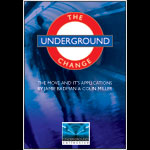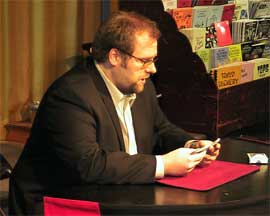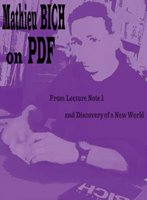
The Cheetah's Handbook Vol. 1 received some great reviews. However, I never had a chance to obtain the e-book before the end of its limited release. Therefore, I was extremely excited to get a chance to read through the second volume.
Under Control (Luke Dancy)- The author describes this as a "spreadless Convincing Control." Basically it allows the performer to control a card to the bottom of the deck while the selection supposedly remains outjogged in the middle. The move "works due to its perfect combination of sleight of hand and discrepancy." The control is not easy, but performed casually looks exceedingly fair. Those familiar with Jason Alford's Angled After Burner may enjoy this variation.
Sweet Cherry Living (Kostya Kimlat)- This is very neat impromptu routine where the performer picks up two cherries and fuses their stems together. The main problem this routine is that I don't imagine you will find yourself in a position to perform it all that often and carrying cherries around just to do this effect would obviously seem a little convoluted. The bright side is the moves used in the routine are simple and natural, so you won't have to practice in advance to understand the handling. This means that the next time you happen to be in front of a bowl of cherries, you are ready to do this routine.
BVA (John Bodine)- This is one of my favorite routines in the notes although it's also one of the simplest. In fact, the entire effect takes less than 20 seconds. The routine makes use of Lee Asher's Asher Twist (or Action Half Pass) but the move is not described. While I won't argue that this routine is better than the original Asher routine, it's nice to be able to perform something different on occasion.
21 Forever (Jamie Badman)- If you have read my review of Jamie Badman's Underground Change Manuscript elsewhere on this site, you know I am a big fan of the move. When the action is motivated, this utility move can be used to great effect. This is one of those effects. A spectator chooses two cards for himself and two cards for the performer to make two Blackjack hands. He is then given the option of exchanging his hand with two different cards from the deck. Finally, he is asked if he would like to switch cards with the magician. Despite his choices being completely free, the performer always ends with a perfect Blackjack. While I do not believe this routine is the most powerful use of the Underground Change, it is a strong effect. Those interested in further applications of this move are encouraged to check out the Underground Change Manuscript and the Underground Collection Volume 2.
Meester Twister (Jack Parker)- A demo video of this effect can be seen at http://www.underground-collective.com/effects/detail.php?product_id=16. Decide for yourself if you like this effect. Personally, I find the handling awkward and the effect rather weak. This was definitely the lowlight of all the routines.
Cherry Bomb (Tyler Wilson)- This will not suit everyone. Some magicians may even find this completely this disgusting. I won't pretend to argue with them. It is...but it is also very original. While I would never be able to make this trick "play," I can imagine this being the perfect offbeat effect for an offbeat performer. This would also be appropriate for many bar situations. In short a cherry is drawn on a card and placed into the performer's mouth. When the card is removed a second later, the cherry is seen to have a tied stem.
Just One Rubber & Get Your Knot Off (John Bodine)- This is a variation on the classic torn and restored rubber band. I must warn you that the author does not provide a method for breaking the band; he simply recommends the performer use his favorite method. The technique for effecting the restoration of the band is much the same as is used in many cut and restored rope restorations: a knot is tied in the band only to vanish leaving the band restored.
Three Card Location Too (Colin Miller)- "Three participants each cut a packet of cards from the deck, remember the card they cut to and then shuffle their cards." The performer then mentally divines each card with no pumping. The author admits this is a variation of Steve Ehler's Three Card Location where the magician divines not only the spectator's selected cards, but also each card in the spectator's cut off packet. This version is more likely to fool magicians that are familiar with the original Ehler routine, but does not end with the revelation of each card in the spectator's packet. You will have to decide for yourself which suits your needs best.
Full Mental Racket (Andi Gladwin)- This is Andi's version of a Syd Segal and JC Wagner's A Logical Lesson. The routine is quick, but the presentation is entertaining. The downside is that the effect may not be worth the six card setup that is required. It's not that a six card setup is particularly extensive, but the effect is not quite powerful enough to warrant having to arrange the pack.
Wings (Kostya Kimlat)- Kostya strikes again with another food related routine. This time he provides a method for the restoration of an eaten chicken wing. I know what you're thinking...why didn't I think of that? Yeah right. I won't explain much more to keep from revealing the method, but I don't imagine you will be practicing this effect much in your living room. Who knows, though? This could be just the routine you have been searching for. My favorite part is Kostya's advice on how to end clean: "ask your kind waitress for a moist towelette." Even if it's not practical in most situations, it is still refreshing to see the creative thinking behind it.
Two Minds Without a Single Thought (Jack Parker)- The spectator selects a group of cards from the center of the deck. Those cards are cut in half, and the top cards of each packet are revealed to be mates (ex: two red Kings.) The advertising blurb for this effect reads "I'm not sure what's more entertaining, the trick or the write-up." The answer is simple, the write-up. This is not to say that the effect is bad, but I imagine I enjoyed the write-up more than my spectator would enjoy the effect.
E.J. Sandwich (Rob James)- The four Aces are placed on the table. A card is selected and signed on the face. The card vanishes and is found face down in between the Aces. Rob's handling is direct, but many magicians will steer clear of the effect due to the somewhat advanced moves employed (ex: Classic Pass, etc.)
Cheetah's Cellphones (Luke Dancy)- Luke has some very clever ideas about how to turn an ordinary cell phone into a magical utility device. I won't describe the ideas here, but I will say some of them are excellent.
Nightmare (Robert Moreland)- This is the classic Cannibal Cards routine using Robert's Ascanio Spread Finesse which is explained in full detail. For those not familiar with the plot, three selections vanish as they are placed one at a time into a packet of four queens. For the finale, the four queens vanish leaving just the three original selections. The routine is well-thought out and the presentation is entertaining. Many on internet magic forums have said this is the best handling of the Cannibal Cards ever. I will not pretend to have enough knowledge of the plot to make this argument, but you should know that others have made this comment.
Whiplash (Andi Gladwin)- Two spectators select a card and the magician selects one as well. The three cards are placed into the magicians hands and the spectators place their hands on top of his. When the hands are removed, only the magician's card remains; the two spectator selections are found face up in different parts of the deck. The advertisement claims that this is an original plot. I am not convinced. At any rate, the handling is somewhat original and certainly interesting. The procedure for controlling the selections could definitely be applied to other effects.
Overall, I was pleased with the material but not completely crazy about it. There are better ways to spend $20, but there are certainly worse. If the effects sound intriguing, shell out your money and make the purchase. Chances are you will find something that suits you. The ideas presented will, at the very least, give you some things to play with. I should mention that if you are interested in obtaining this e-book, you better act fast. According to the website, they will only be on sale until 250 copies are sold or the end of May 2006, whichever comes first.
-Available from www.Underground-Collective.com








